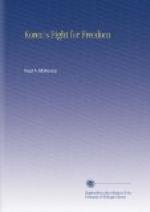In the evening, after I had settled down in the yard of the native inn, the elders of the Church came to see me, two quiet-spoken, grave, middle-aged men. They were somewhat downcast, and said that their village had suffered considerably, the parties of soldiers passing through having taken what they wanted and being guilty of some outrages. A gardener’s wife had been violated by a Japanese soldier, another soldier standing guard over the house with rifle and fixed bayonet. A boy, attracted by the woman’s screams, ran and fetched the husband. He came up, knife in hand. “But what could he do?” the elders asked. “There was the soldier, with rifle and bayonet, before the door.”
Later on I was to hear other stories, very similar to this. These tales were confirmed on the spot, so far as confirmation was possible. In my judgment such outrages were not numerous, and were limited to exceptional parties of troops. But they produced an effect altogether disproportionate to their numbers. The Korean has high ideals about the sanctity of his women, and the fear caused by a comparatively few offences was largely responsible for the flight of multitudes to the hills.
In the burning of villages, a certain number of Korean women and children were undoubtedly killed. The Japanese troops seem in many cases to have rushed a village and to have indulged in miscellaneous wild shooting, on the chance of there being rebels around, before firing the houses. In one hamlet, where I found two houses still standing, the folk told me that these had been left because the Japanese shot the daughter of the owner of one of them, a girl of ten. “When they shot her,” the villagers said, “we approached the soldiers, and said, ’Please excuse us, but since you have killed the daughter of this man you should not burn his house.’ And the soldiers listened to us.”
In towns like Chong-ju and Won-ju practically all the women and children and better-class families had disappeared. The shops were shut and barricaded by their owners before leaving, but many of them had been forced open and looted. The destruction in other towns paled to nothing, however, before the havoc wrought in Chee-chong. Here was a town completely destroyed.
Chee-chong was, up to the late summer of 1907, an important rural centre, containing between 2,000 and 3,000 inhabitants, and beautifully situated in a sheltered plain, surrounded by high mountains. It was a favourite resort of high officials, a Korean Bath or Cheltenham. Many of the houses were large, and some had tiled roofs—a sure evidence of wealth.
When the “Righteous Army” began operations, one portion of it occupied the hills beyond Chee-chong. The Japanese sent a small body of troops into the town. These were attacked one night on three sides, several were killed, and the others were compelled to retire. The Japanese despatched reinforcements, and after some fighting regained lost ground. They then determined to make Chee-chong an example to the countryside. The entire town was put to the torch. The soldiers carefully tended the flames, piling up everything for destruction. Nothing was left, save one image of Buddha and the magistrate’s yamen. When the Koreans fled, five men, one woman, and a child, all wounded, were left behind. These disappeared in the flames.




